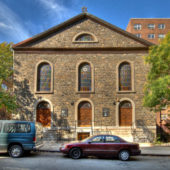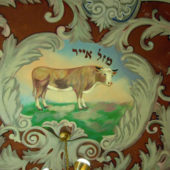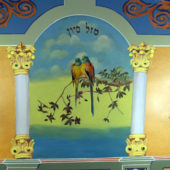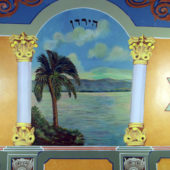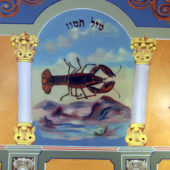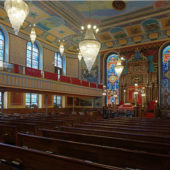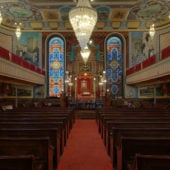Originally built in 1826 as a Methodist Episcopal Church, the building was purchased in 1905 to serve as a synaogue for Jewish immigrants from Bialystok Poland.
Bialystoker Synagogue is situated in New York City’s Lower East Side. It is a tremendously vibrant synagogue, not only visually, but also in its effect in the community.
In the 1860s and 1870s, a group of Orthodox Jews from Bialystok, Poland settled in the Lower East Side of New York City. In 1865, they assembled as Chevra Anshei Chesed of Bialystok, first at Hester street, then moved to Orchard Street. In 1905, the congregation merged with a second congregation from Bialystok. In order to accommodate both congregations, premises were purchased from a Methodist church for $150,000, on Hester Street. The congregants named the new congregation Bialystoker Synagogue. This is the present day premises; however, the street name has been changed to Bialystoker Place. Initially, the building was very plain and there was disagreement amongst the members whether to spend the money to decorate it. Once The Great Depression began, it was decided that to lift the spirits of the congregants, the synagogue’s murals and stained glass windows would be restored. An imposing Ark was built in Italy and shipped to New York. It was carved wood, gilded, and 3 stories tall. It was hand-painted with pastoral scenes of Creation and the zodiac. One is transported back in time by the opulent carved, gilded Ark at the front of the sanctuary, flanked by arched stained glass windows, with murals entirely covering the walls and ceiling, deep red carpet and fabric on the Ark, front table and steps, the beautiful wood pews and glistening chandeliers.
The Synagogue is constructed in the late Federal style. The exterior of the building is constructed with Manhattan schist, from a nearby quarry on Pitt Street, with three arched windows, doors with arched frames and low brownstone steps leading to the entrance. The low pitched pedimented roof also features wooden cornicing and a lunette window. Because the synagogue was constructed in typical Orthodox fashion, there is an upper balcony from where the women can partake of the services. In the corner of the women’s gallery is a small wooden door, which leads up to the attic. There are tales told that prior to the Shul having moved to the premises, the hidden doorway in the balcony of the women’s chambers leads to the attic, which was used by the Underground Railroad as a stop for escaped slaves. In 1988 the building was renovated and the stained glass windows restored to their original beauty. The Hebrew school was renovated and reopened as a separate structure, named The Daniel Potkorony Building.
Bialystoker is one of only two synagogues registered as historic landmark in on New York’s Lower East Side. It was listed in 1966.
The Shul presently offers four Minyanim (prayer quorums) daily and a fifth on Sunday to its congregation of over 400 families. According to Rabbi Zvi David Romm, the synagogue’s Rabbi, this is the most worship services offered by any Synagogue in Manhattan!
As part of Bialystoker’s ongoing outreach program, upscale singles Shabbatons are held with over 100 singles attending from as far as Maryland, seeking spouses. Gourmet food is served. The individual care and attention lasts not only on the evening, but afterwards, is followed-up with calls and match-making advice!
The Shul shows its concern for the neighborhood by being a part of “Lower East Side Family Health Day,” where residents have periodically come for free screenings for: depression, dental, podiatry, glaucoma, vision, glaucoma and glucose. Rabbi Romm, is quoted as saying, “Judaism stresses the importance of properly caring for one’s body, which is, after all, the repository of the soul.”

